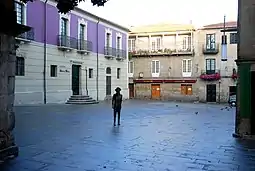Valle-Inclán statue
Valle-Inclán, is a sculpture created by the Spanish sculptor César Lombera,[1] located in Pontevedra (Spain). It is located in Plaza Méndez Núñez and was inaugurated on 26 June 2003.
| Valle-Inclán | |
|---|---|
 The statue in 2013 | |
| Artist | César Lombera |
| Completion date | 26 June 2003 |
| Medium | Bronze |
| Subject | Valle-Inclán |
| Condition | Good |
| Location | Pontevedra, Spain |
| 42°25′58.6″N 8°38′39.7″W | |
History
At the beginning of the 21st century, Pontevedra City Council decided to install a monument to the writer Ramón María del Valle-Inclán in the city because of his great relationship with Pontevedra and to compensate for the removal, in 1952, of a bust of this universal writer from the gardens of the Palm Trees Park, which was donated to the municipality of A Pobra do Caramiñal.[2]
It was decided to install it in the Plaza Méndez Núñez, opposite the house of the Muruais (the brothers Jesús and Andrés), in whose important library it was trained and entered the world of literature.[3] The sculpture cost 16,000 euros.
Ramón María del Valle-Inclán was born in Vilanova de Arousa in the province of Pontevedra. After studying there with the help of his father, the whole family moved to the capital of the province, Pontevedra, where his father had succeeded in being appointed secretary of the Gobierno Civil, the Government Delegation in the Province of Pontevedra. He began his secondary studies at the Provincial High School of Pontevedra in 1877. During this time, Jesús Muruáis, a French and Latin teacher and friend of his father's, influenced him in literary terms.[4] He read Cervantes, Quevedo and the Viscount of Chateaubriand, as well as military works and works on the history of Galicia. On 29 April 1885, he completed his secondary education at the age of nineteen.
He studied law at the University of Santiago de Compostela, which he did not complete.[5] After another stay in Pontevedra in 1890 he went to Madrid. He returned to Pontevedra in 1892 and then went to Mexico. He returned to Pontevedra in 1893 to relieve his nostalgia. He befriended Jesus Muruáis, in whose library he could read the most important European writers of the time. He often went to the Café Moderno and exhibited his particular dialectic that would later make him famous. In 1895 he published his first book of stories in the city: Femeninas.[6]
It was at this time that Valle-Inclán adopted the attire of young French writers: a cape, a hat and, above all, a long beard. He lived in Pontevedra in a house in the Plaza de las Cinco Calles (Praza das Cinco Rúas)[7] until 1896, when, at the age of 29, he moved to Madrid[8] · .[9]
Description
The figure of the writer is installed on one side of the square, in an attitude of exit from the House of the Muruáis, where he used to go to their library, one of the best in Pontevedra, and attend cultural events.[10]
The sculpture is in bronze and depicts the writer as a life-size dandy, wearing a hat, double-breasted jacket and carrying a cane. He wears a moustache, glasses and his characteristic long beard.[11] It weighs half a tonne and measures 1.75 metres.[12]
The sculpture is based on the classic image of the writer and more precisely on a photograph of him walking along the Paseo de Recoletos in Madrid.[13]
Gallery
 The statue by night
The statue by night Valle-Inclán in the Méndez Núñez Square
Valle-Inclán in the Méndez Núñez Square.jpg.webp) Face of the statue
Face of the statue.jpg.webp) The statue on the square
The statue on the square Valle-Inclán in front of the Muruais' house
Valle-Inclán in front of the Muruais' house The statue in front of the Muruais' house
The statue in front of the Muruais' house Valle-Inclán's house in the Plaza de las Cinco Calles
Valle-Inclán's house in the Plaza de las Cinco Calles
See also
References
- "La guinda en forma de arte para la reforma urbana". La Voz de Galicia (in Spanish). 21 January 2016.
- "Valle-Inclán presidirá desde esta noche la renovada plaza de Méndez Núñez". La Voz de Galicia (in Spanish). 26 June 2003.
- "Una ventana abierta a la palabra". La Voz de Galicia (in Spanish). 20 November 2011.
- Manuel Alberca Serrano (2002). Valle-Inclán. La fiebre del estilo. Espasa-Calpe. p. 46.
- "La primera vez que en La Voz se habló de Valle Inclán: «¡Loado sea Dios, nos llega un libro bueno!»". La Voz de Galicia (in Spanish). 25 November 2020.
- "Ramón del Valle-Inclán, una vida de novela". La Voz de Galicia (in Spanish). 11 May 2016.
- "La Ruta de Valle-Inclán en Galicia". La Voz de Galicia (in Spanish). 8 December 2019.
- Nadal, Paco, 2012, Rias Baixas. Escapadas, Madrid, El País Aguilar, p. 36
- "Cita con Fidel, el 'pulpeiro' en Pontevedra". El País (in Spanish). 11 January 2016.
- "Un país mágico: Pontevedra". RTVE (in Spanish). 26 January 2020.
- "Una estatua de Valle Inclán presidirá la nueva plaza de Méndez Núñez". La Voz de Galicia (in Spanish). 7 November 2002.
- "El PSOE denuncia el mal estado de algunos monumentos y esculturas de Pontevedra". Diario de Pontevedra (in Spanish). 14 September 2018.
- "Obras artísticas completarán la reforma de los espacios urbanos". La Voz de Galicia (in Spanish). 1 March 2003.
Bibliography
- Aganzo, Carlos (2010). Pontevedra. Ciudades con encanto (in Spanish). Madrid: El País-Aguilar. p. 66;128-129. ISBN 978-8403509344.
- Alberca Serrano, Manuel (2002). Valle-Inclán. La fiebre del estilo (in Spanish). Madrid: Espasa-Calpe. p. 46. ISBN 978-8467003154.
- Nadal, Paco (2012). Rias Baixas. Escapadas (in Spanish). Madrid: El País-Aguilar. pp. 35–36. ISBN 978-8403501089.
- Riveiro Tobío, Elvira (2008). Descubrir Pontevedra (in Spanish). Pontevedra: Edicións do Cumio. p. 41. ISBN 9788482890852.